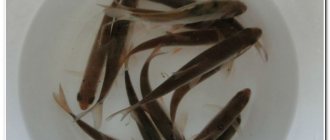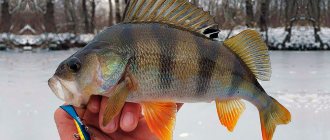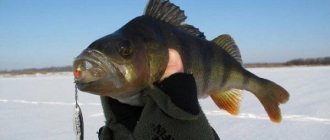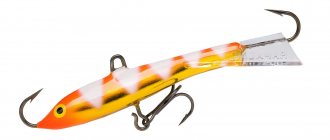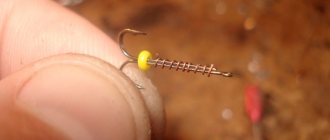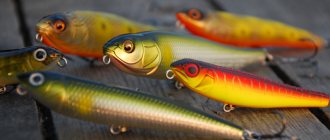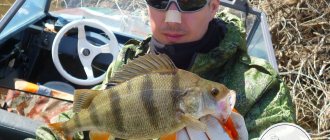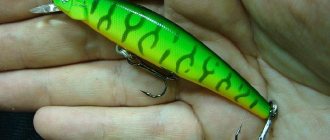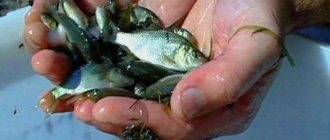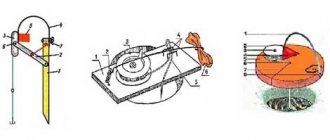Important introductory note
A simple freshwater river perch is one of the many representatives of ray-finned fish, which, in addition to it, also includes such well-known fish as Ruff, Blue Marlin, Ratan and many other predatory and relatively predatory species. From this we can reasonably conclude that ray-finned fish have settled well almost everywhere - from the endless waters of the Pacific Ocean to little-known rivers like the Miass, which flows in the depths of the Eurasian continent.
One of the most famous and widespread fish of this family is our today’s hero - river perch. So much has already been said about him that there is nothing to add. However, we will still try to tell you a little more about this little sharp-finned and striped prankster than usual.
The perch attacks so quickly and selflessly that sometimes it seems as if lightning flashed over the surface of the water. Therefore, fishing with live bait can be either very successful or not at all as the fisherman himself would like.
At this stage, a reasonable question arises: where to get live bait? In fact, everything is very simple. The first thing you need to do is bring a jar of worms and a piece of bread with you to the pond. Periodically, alternately feed the fish first with one delicacy, then with another snack and wait. Soon there will be many small-sized fry and simply not large enough “trash” fish, among which, of course, the perch itself may be present.
There is nothing wrong with using perch as bait for another - its larger brother. Perches are cannibals, not all, but many. Adult individuals are excellent at distinguishing their own kind, but for some reason some of them do not disdain to feast on perch flesh at their leisure. These are the preferences that can only be explained by the presence of some kind of innate program designed to independently prevent an overabundance in the striped population.
Catching live bait with traps
One of the most common ways to catch fry. Traps are made from different containers, for example, from a plastic canister in which holes are made. A piece of bread is placed in it and within a few minutes the container is full of fry.
Catching live bait with your snout
A muzzle - a device for catching fry is not difficult to make yourself. This is a container made of metal mesh to which a rope is tied. By throwing such a net, you can catch many fry at one time. You can see the effectiveness of the muzzle by watching the video.
Watch the video: Catching live bait with your snout. How to catch live bait?
Catching live bait with a plastic eggplant trap and making it
- We cut off the upper part of the container (about 5 liters), where the narrowing begins.
- We insert the cut part with the neck inside the container and secure it with wire.
- We make holes around the perimeter of the container using a knife; there should be a lot of holes, but not large ones.
- We tie the container with a rope and attach a weight to the rope, otherwise the plastic container will not sink under the water.
- We throw in complementary foods or just crusts of bread.
- We check the catch after half an hour.
Watch the video: Fishing for live bait. The most effective way to catch live bait
Catching live bait on a lift or spider
If you also lure the fish with complementary food, sprinkle a little bran, which will create a cloud, and then a school of fry can be picked up using a landing net or spider.
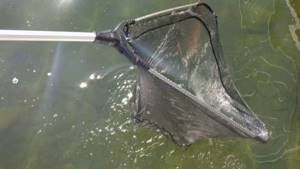
A spider is a metal frame that can be disassembled, covered with a fine-mesh mesh.
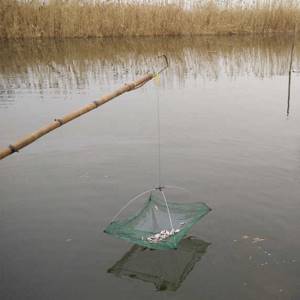
You can catch with fine-mesh nets - larvae. They are lowered to the bottom with bait made from bread crusts.
Watch the video: Fishing for live bait using a lift
Catching live bait with a float rod
The method of catching live bait using a float rod is very popular. The advantage of this method is that it is enough to take with you a light fishing rod, a small hook, and a light float.
As soon as you catch the first live bait, you can put it on the predator, and continue to harvest the fry yourself. This method is suitable for fry of perches, ruffes and minnows.
All the methods described above are more suitable for summer. How to catch live bait in winter?
How to get the fry correctly

Tip: take two buckets. The first of them is that it will be smaller for live bait, and the second, of course, is for trophy or just large perch. Take a net, and as soon as the fish begins to appear on the surface, eating the bread or worms thrown to it, immediately grab it with the net in whole handfuls from the water. This whole procedure will take you 15-20 minutes at most, but then you won’t have to think about where to get live bait.
Perch loves live bait. This is especially true for those reservoirs where, in the course of an increase in the number of fishermen of different stripes, there has been a dominance of the use of newfangled gadgets, which perches can no longer “look at.” Against their background, live prey will seem to the striped reckless fish to be a normal fish, which does not at all resemble and cannot resemble the suspicious-looking bait of some malicious person with a stick in his hands.
Humpback whales become so large only after long and painful years of constant survival against the backdrop of aggressive neighbors like catfish, pike perch and pike, which swim past every now and then, because they prefer to settle in approximately the same reservoirs as the ill-fated perch:
- clean running water
- wide floodplains
- large lakes or semi-freshwater seas
- algae thickets, sloping bottom, rocks
Perch has many enemies. Too much. After all, he is small. He will have nowhere to run if he comes face to face with some catfish that suddenly appears in his native thickets. Even an experienced perch is nothing compared to the far from largest bottom pike. And in order to survive, perches begin to behave as secretly as possible, do not stick out too much, sit between the stones and only go out on their quiet hunt in a relatively short period of time between evening and late at night.
The old individuals did not have the former agility of the small youngsters, who in schools of 300 tails rushed across the entire water area in chaotic directions, catching up with their food even smaller fish. Those times are now 5-6 years behind us, or even 10. Both the humpbacks and the sailors started it all together. Together they began their journey from eggs. Together they ran in flocks along rivers and lakes.
Together they shared the spoils with each other. But growing up in such conditions was practically impossible. Thus, after about a year or two, perches begin to move away from the global school towards smaller formations - from 30 to 100 tails. And so on, until eventually, already seasoned, the perch is left alone.
After all, all their brothers were devoured either by pikes, or people, or he himself. Now all that remains is to take care of your own safety - a rocky bottom is the best option for this. It would be good if there were branchy trunks of fallen trees rotten from moisture on top. You can hide in them from the huge mouth of a bottom pike or catfish. A distant relative of the perch, the saltwater-loving blue marlin reminds us of our hero. He also starts out in a pack and ends up in splendid isolation.
He also does not have many enemies, because the only threat comes from the great white shark and the mako shark. The sharp, hard nose allows you to inflict significant damage even on them, so once again, sharks that are not large enough will prefer to swim past rather than compete with a sharp-nosed ram, which at any moment with great speed can slam its spear right into their soft stomach.
And our perch, the humpback fish, is not as simple and harmless as it seems. Even if they eat it, they will die with a probability of 70% of cases. Very hard and sharp spines on its crest are capable of tearing the delicate insides of a predator and dooming it to death in terrible agony. It is possible that at the genetic level, the same pike has certain programs that protect it from colliding with a perch that has an overly impressive crest.
In any case, the perch itself does not pose much of a threat to large enough fish. Its mouth is not so huge that it can use a vacuum to suck in fish larger than a certain size. He is a hunter of small and numerous fish. Sometimes you don’t mind picking up some floating bug. Lonely small prey will also be to his taste. He will clearly be interested in this easy prey. And the fisherman should take advantage of this, because it will be difficult to attract the attention of the “old man” otherwise.
The main thing here is to avoid unnecessary attention from small perches, which will constantly climb in and create interference. To do this, you need to know where to “hunt” for large perch.
More ways to get fry, including homemade ones - video
Perch for fry
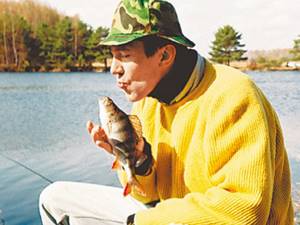
photo by the author
But here's the thing. All artificial baits, in my opinion, have one significant drawback. More or less successfully executed, they are just copies of living organisms.
When fishing for perch, I have more than once been convinced that in some reservoirs, especially enclosed ones, the striped predator takes exclusively on fry. A live fish most likely attracts him not only with its believable movements, its appearance, but also with its smell. Agree, the same smelt and bleak smell differently. However, first of all, let’s figure out what kind of fish we should call a fry. Unlike live bait with a length of 7–12 cm, used by fishermen, as a rule, when catching pike and pike-perch, whitebait does not exceed a length of 4–5 cm. This can be redfish, bitterling, minnow, juvenile roach, bleak, etc.
WHERE TO CATCH FRY
Before you go to a perch pond with a float rod, you need to catch a sufficient number of small fish. You can get them off the coast using a fine-mesh rectangular lift (mesh size 80x100 cm). Lifts also come in round shapes. A small weight is tied to the bottom center of the net, and a handful of bread crumbs or other bait is thrown onto the top of the net to attract the fry. Using a telescopic handle approximately 2 m long, the lift is lowered into the water and they wait for the fish to enter it, after which they sharply raise the net and collect them. Fingerlings of asp, ide, and chub can get into the lift. They should be released carefully. Don't forget that in the future they can become your worthy trophies.
It also happens that there are a lot of perch in a reservoir, but getting a fingerling is a problem. In such cases, a couple of valuable morning hours have to be devoted to working with the lift where there is an abundance of small fish. Along the Kaluga Highway, for example, I quite often visit a cascade of ponds, two of which are inhabited by perch, and the others by crucian carp and small fish such as verkhovka and mustard.
Perch fry are usually not stocked for future use, as they are less tenacious than larger pike bait fish. When fishing, it is best to store fish in a can, refreshing the water from time to time.
The fry is placed on a single hook by the upper lip or nostril, sometimes under the dorsal fin or by the tail, with the tip of the hook pointing out. The first option is preferable, since in this case the fish is least injured and remains viable longer. During periods of perch feeding, when fishing in the current, you can use dead live bait or its pieces.
SUBJECT TO CONDITIONS
As you know, the choice of one or another method of fishing and the method of presenting bait is largely determined by the conditions at the fishing site. In recent years, for example, step fishing has become widely accepted among spinning fishermen. However, it is only good if you fish in areas of the reservoir with a clean, gristly or sandy bottom. Similar conditions can be found on navigable rivers, in backwaters, and sand pits.
Perch most often has to be caught among water thickets, snags and other strong places. Here, at best, you can move the bait in the upper or middle layers of the water, which does not always bring success: any spinning angler, having left a dozen expensive spinners on underwater snags in the morning, will kindly remember the times when, when catching perch, he used a simple tackle - a float rod with a fry attached to a hook.
I often give preference to fry not only in snagged rivers, but also in reservoirs, where stumps, fallen tree trunks, and bushes went under water when the river floodplains were flooded. In addition, we have many reservoirs where, due to the prevailing circumstances, perch are best caught on fry. It happens that the neighbors of a striped predator (roach, rudd, bream) fall into a stupor and do not take it when the weather suddenly changes, and in the meantime the perch becomes active. Let me give you a couple of examples from practice.
One day, my friend and I came to go fishing in the quarries located near the town of Savelovo near Moscow. We focused on catching perch with a spinning rod, but after trying a bunch of spinners and soft baits, we were forced to switch to float rods. Having made sure that the perch would not even take bloodworms, we caught several dozen tops for bait using a lift. Fishing became more fun. The perch was measured, the size of a palm. A cold north wind blew all day, and in such weather, as local fishermen told me, in the quarries there is no other fish except perch.
Another time I went to a small paid pond, where, in addition to carp and crucian carp, perch had multiplied in recent years. Taking into account the sudden cold snap, just in case, when leaving the house, I stuffed a cage and a lift into my backpack.
On the pond, while crucian fish and carp fishermen were complaining about the bad weather, I caught about three dozen crowns under the shore and retired to a narrow bay near the mouth of the stream, where the depth was up to three meters, and in places snags stuck out of the water. Soon the shores were empty. By 12 o’clock in the afternoon, left in splendid isolation, I “groped” for the perch and until the evening, although with interruptions, I successfully caught it with fry. I finished when in the approaching twilight it was already difficult to distinguish the float.
Any novice angler can quickly master catching perch with fry. But here there are some nuances that are useful to know.
WITH FLOAT
At the beginning of autumn, when the water has cooled noticeably, schools of perch actively move around the reservoir in search of food. It should be taken into account that although perch is an omnivorous predator, the basis of its diet is still small fish. In any body of water it is a familiar and accessible food for it. It is precisely with this feature of the striped predator in mind that we have long practiced fishing with a float rod for fry. And even now this method has many fans among modern fishermen.
For fishing with a float rod with a blind rig, any rod with a soft tip is suitable: the perch has rather weak lips, so it should gently cushion both when hooking and when playing. The length of the rod depends on the fishing location. As a rule, I fish with five to six meters. A fly fishing rod is the most acceptable option; it allows you to gently and accurately deliver such a delicate bait as whitebait to the fishing point.
I usually use fishing line with a diameter of 0.12 to 0.20 mm. The color is not decisive. But strength - yes. It’s better to spend money on a high-quality one than to lose a trophy when biting a large perch. The thinner the line, the bolder the predator takes the bait.
Choosing a hook is an extremely serious matter when catching any fish. Our case is no exception. The main characteristics of perch hooks are grip, shank length, and wire thickness. The most universal are considered to be hooks with a medium-length shank and a slightly concave tip, No. 11–13. The choice of size depends on the size of the fry and the expected catch. Hooks made of thin wire ensure the vitality and mobility of the fish. And this is sometimes of paramount importance.
When fishing for whitebait, the float is chosen taking into account the fact that the perch that grabs the bait usually leads it to the side or drowns it right away. Therefore, its shape must be designed for unhindered immersion. On the other hand, when sinking a perch float, the use of the so-called zero buoyancy option is excluded, because in this case, even the smallest fish will constantly drag the float under the water and get tired faster. A large shot or “olive” is usually used as a sinker. Leash length 15–20 cm.
When fishing at a depth of 1–1.5 m, the best results are obtained by using floats painted in protective colors: gray, brown, green, black. Float tackle with a reel requires a rod 3.5–4 m long. The reel is preferably inertia-free, with an open spool. Simple wire reels are not suitable for fishing from the shore and are only appropriate when fishing in the current from a boat or bridge.
Where fishing with a float is fraught with snags, it is quite appropriate to fish with a fishing rod with a side nod. A fish placed by the edge of the upper lip on the hook of a jig does not have to be mobile. On the contrary, the calmer it is, the fewer holds there are. The perch perfectly sees what is happening around it at a depth of 1–1.5 m. Therefore, in strong places, it is not necessary to lower the bait to the bottom; it is enough to play it smoothly in mid-water.
FISHING TACTICS
In most reservoirs, especially large ones, perch constantly moves; its behavior during the day cannot be fit into any patterns. It usually groups where there is food. But sometimes finding a school of perch is only half the battle. It may well turn out that the predators have previously wreaked havoc on the accumulation of small fish, have had their fill and will now digest the food for a long time, not paying attention to the offered bait. This means that you need to continue your search and try to find a taking perch.
It is good to catch river perch in pools under steep banks, in areas with weak and reverse currents, and in bays overgrown with grass. Along steep banks you can move up or downstream, throwing live bait into pools, bushes and snags. Here you come across not only medium-sized perches, but also respectable humpback whales, waiting for prey in the dark depths. During the autumn run of perch schools, success is often brought by wait-and-see tactics, that is, fishing in one or two places that you like.
In large bodies of water (lakes, quarries, reservoirs), you need to know well the traditional stopping places of the striped predator. Seagulls often act as guides here. They usually hunt where there are concentrations of small fish, and therefore predators. Under the shore and in overgrown shallow waters remote from it, a school of perch reveals itself by the fact that small things walking near the surface are from time to time thrown out of the water in silvery splashes. Immediately followed by dull blows, sometimes slurping sounds. Large humpback whales fatten this up. This is where you need to catch.
However, the absence of such visual “manifestations” does not mean that the place is empty. It happens that forage fish go to depth (for example, when it gets cold), and perch hunting takes place at the bottom or in mid-water, invisible to the eye.
Early in the morning, if the perch hits close to the shore, I try not to come close to the water's edge. And I make the first casts carefully, from a certain distance, maintaining camouflage so as not to frighten off the approaching flock. Fishing in the morning fog can be very effective. In general, the morning bite is usually more active than the afternoon or evening bite. The exception is cloudy weather, when perch can catch more or less evenly throughout the day. The same can be said about fishing in late autumn.
Problems when fishing for fry arise if, in parallel with the perch, other predators, especially large ones, become active. You urgently have to use a thicker fishing line, and with pike bites, you also need a metal leash, which negatively affects the perch’s bite. But isn’t it better in such situations to put the fishing rod aside, assemble the spinning rod and “deal” with a more respectable predator first?
Vladimir Kazantsev September 27, 2011 at 17:00
Where and when to fish
The humpback prefers to settle near the shore, where the bottom is replete with large stones. Reeds may not always be of interest to large perch, because they do not protect the weakest inhabitant of freshwater bodies from other predators. Pike generally consider reed thickets to be their domain, thus driving perch into rocky corners. This is true for rivers. In lakes, especially large ones, even schooling perches can grow to a significant size of 600 grams, despite the fact that the school itself will number up to 100 tails.
In the rivers you need to go out for humpback whales at dusk - from seven o'clock in the evening to 11 o'clock at night. Sometimes you can stay until two o'clock in the morning, but this is rare. Night is the time for pike and other river monsters. In lakes, schooling large perches can rush around the water area during the daytime, while in the evening and at night you won’t find them even with fire. In peat lakes, humpback whales, despite everything, go hunting from about seven o'clock in the morning until noon. Sometimes they crawl out in the late afternoon, but strictly before sunset. Apparently, this is again due to the fact that peat lakes are the favorite habitats of the eternal enemies of perches.
Features of fishing at different times of the year
In summer, perch are dispersed throughout the entire water area. The humpback sits in the same place all year round, with the exception of especially cold winters, when it goes to the deepest areas to bury itself in the silt and wait for some time, without touching anyone.
Catching perch with fry in winter involves the use of special jig-free gear equipped with three multi-directional hooks, reinforced with a tin connection in the center, which are used on their own, even without the presence of spinners. In this case we are talking about fry as bait. But in this case, the best solution would be not to use the fry itself on the hook, but to feed the fry in the hole, and throw gear there, which, through special manipulation, can attract the attention of some fat-bellied giant of the perch family.
Catching perch with fry in the summer requires the angler to have a lot more maneuvers. Here you can use both a regular retractable casting rod and an ultra-technological modern spinning rod. The baitfish is hooked and sent into the water at a distance of five meters from the shore, on average. If there is no catch, then you need to move 10 meters away from the original position. After walking around, you will probably catch, if not a trophy, then certainly not a tiny minke whale.
Tactical features of fishing

Catching perch for fry in the summer with a float rod is by no means a delicate matter, but rather the opposite - even a complete beginner or a child can cope with it. The main thing is to prevent the fishing line from getting tangled on the coastal snags that striped beasts love so much. Fishing for perch using live bait leads to a 90% successful outcome. And the larger this fry, the larger will be the one who bites on it. Live bait that is too large is unlikely to be of interest to young sailors.
But even an overly large pseudo-fry will attract the attention of some pike, and the perch will remain a cautious observer; in this case, he will not risk making a dangerous lunge in front of the owner of freshwater reservoirs, because a seasoned perch will certainly be exposed to suicidal tendencies won't succeed.
Was it because he grew to his 4-5 kilograms (phenomenal for a perch) because he was very careful? Use live bait with extreme caution. Make sure she doesn't die prematurely. Let it behave in the most natural way, do not interfere with the course of its movement, watch and do not lead it, as soon as the perch bites, then you will need to drag the ready-made one to the shore (or to the boat) as hard as you can.
Choosing a place to catch perch
Considering that perch is a sedentary fish and will not go far from its camps, fishermen go fishing in late autumn, and by how the perch bites, they determine its intended winter camp site.
We also recommend reading:
Attractant for predatory fish: baits for pike perch, pike, perch Catching perch in winter with spinners Catching perch in winter with a balancer Jigs for winter perch fishing
How to choose gear
Perch, as you know, is not the most picky fish. Even an ordinary float fishing rod, equipped with a simple non-inertial reel, a simple fishing line with a diameter of 0.5 millimeters, an ordinary spoon, provided that there is live bait, will bring you the treasured catch. The main thing is to remain calm and steely self-control, without interfering with the process of moving the bait itself through the water, otherwise the humpback will sense a catch and hide between its stones, leaving you alone with the fry.
Fishing for fry and catching perch video
Fishing for perch using live bait is one of the most effective ways to defeat a cunning opponent in a fight. We are talking about humpback whales, while small perches are unlikely to be at all interested in fish as bait, because the basis of their diet is various microorganisms.
For a better understanding of the material presented here, we recommend watching this video, which may be useful and instructive for you. Try not to neglect the advice given in this article. Ultimately, the success or failure of all your endeavors and attempts to achieve an outstanding result and finally get the desired trophy will depend on this.
